EnDyk/iStock Editorial via Getty Images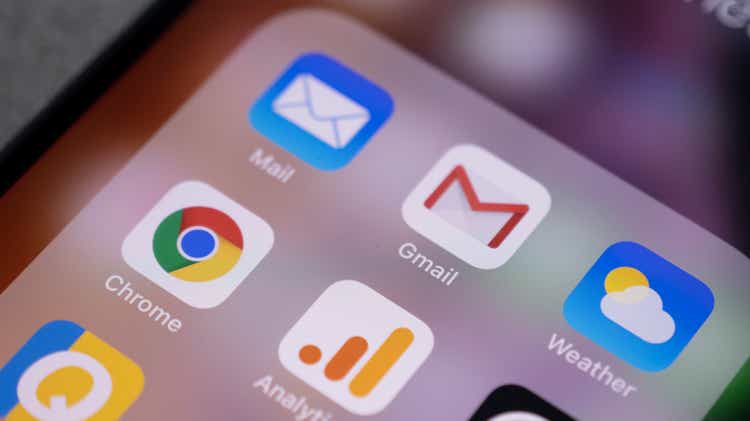
Investment Thesis
After Google (NASDAQ:GOOG) reported its results on April 26, its share price fell by more than 10% during after-market trading. And as I wrote this (before the market opened on April 27), its share price is still down by more than 4.5% ($2280). The prices might have changed a bit again when you read given the market volatility. In my view, such share price moves are irrational, and the market has overacted (the market has already been on edge in recent days to start with).
Warren Buffett regretted in 2019 for making the wrong call in not buying GOOG. All these reasons for his regret are still valid now, and probably even more so after the Q1 earnings release reported yesterday, for the following considerations.
First, the business still fits all the traits that he looks for in a perpetual compounder – the wide moat, the toll status in the economic ecosystem, and incredibly high return on capital employed. GOOG not only reported a strong Q1, but its underlying business is still strong as ever and is well-positioned for the future at the same time. Total revenues grew by more than 20% YoY and the operating margin is stable at a very competitive level of 30%, as you can see from the chart below.
Second, the business generates strong cash flow to support both organic growth, acquisitions, and reward shareholder generously via share repurchases. In particular, CEO Pichai mentioned that “Cybersecurity has been a particular focus… we obviously are excited about our acquisition of Mandiant (MNDT).” Also, shortly before the earnings release, the Board of Directors authorized a new share repurchase plan and upsized the old plan up to an additional $70.0 billion of its Class A and Class C shares
Finally, the recent selloff has brought the valuation to a compressed level. Currently, the accounting PE is below 20x. And the PE based on true economic earnings is even lower. Such a valuation, combined with the strong business fundamentals and growth potential, can easily support a double-digit total return in the long term.
Now, we dive into the specifics of the earnings and address some of the key market concerns.
GOOG Q1 Earnings Report GOOG Q1 Earnings Report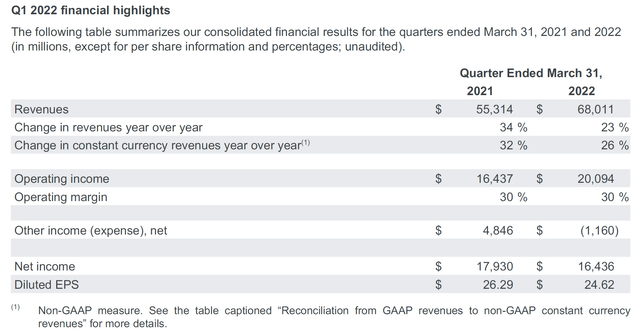

Earnings Highlights And Market Concerns
As you can see from the following chart, GOOG reported superb growth in Q1 across the board. In particular:
- Its core bread-and-butter business, Google Advertising, saw a 22% growth in its total revenues. This core includes the familiar Google Search, YouTube, and Google Network. And their revenues all grew in the double-digit range (Google Search & Other grew about 24%, YouTube Ads grew about 14 %, and Google Network grew more than 20).
- Its Cloud segment grew more than 45% in total revenues. Admittedly, Google Cloud is still not profitable yet and its operating loss was even a bit higher than the same quarter last year (by about 4%). But the Google Cloud Platform is in a dominating position together with Microsoft Azure and Amazon AWS in this strategic new area. It provides a broad set of capabilities, covering a full range of enterprise IT needs from SaaS to PaaS and IaaS. I have no doubt that it will become profitable soon and enjoy high growth given the secular support and the world’s tetanic shift towards the pay-as-you-go model.
GOOG Q1 Earnings Report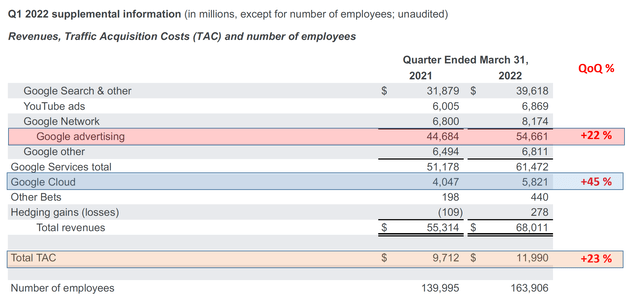
Now let’s examine the not-so-good aspects and address the market concerns. First, YouTube’s growth slowed down. YouTube Ads grew “only” by ~14 %. In contrast, it grew more than 25% in the previous quarter. This deceleration came alongside some industrywide advertising hiccups with the start of the Russia-Ukraine war. And my view is that A) 14% growth is already spectacular, and B) the slow down most likely will be temporary. As Chief Financial Officer Ruth Porat noted,
“The most direct impact (of the war) is the fact that we suspended the vast majority of our commercial activities in Russia… About 1% of Google revenues were from Russia in 2021, and that was primarily from advertising”. She adds that from the outset of the war there was a pullback in advertiser spend, “particularly on YouTube in Europe.”
Another concern surrounding YouTube is the competition with rival TikTok (BDNCE) in short videos. Again, my view is that such concern is overblown. YouTube shorts are growth a rapid pace and catching up quickly. From CEO Pichai’s remarks, YouTube Shorts now averages over 30 billion daily views, up more than four times from a year ago. It will take some time for YouTube to monetize but the results are promising so far, as commented by CFO Ruth Porat,
“We are testing monetization on Shorts, and early advertiser feedback and results are encouraging,” she says. “And the team is focused on closing the gap with traditional YouTube ads over time. So we’re excited about the new opportunities with Shorts, but a slight headwind.”
Finally, the real concern to me is the rising cost of TAC (Traffic Acquisition Costs). The TAC is one of the company’s most significant, yet difficult to model, costs (and hence the least discussed). A full discussion of the TAC probably merits more than one article. And here I will briefly summarize my views. Firstly, TAC is the cost that Google has to spend to acquire traffic. It includes the costs that GOOG pays to its network members and also its distribution partners. Second, unfortunately, the TAC has been rising at a rapid pace too as competition in the digital ad world intensifies. As seen, TAC rose by 23% QoQ, slightly outpacing the revenue growth in its core segments (22%).
I would not be alarmed by this small difference; however, it is a fundamental metric that needs to be closely monitored. As aforementioned, it is a key cost for GOOG and the competition in the digital ad space could further drive up this cost. At the same time, GOOG’s efforts to diversify its ecosystem could help stabilize it (such as the spread of its Chrome browser and Android OS).
Valuation And Buffett’s Value Line
Moving on to valuation. The market overreaction has brought the valuation to a compressed level (the accounting PE is below 20x as of this writing). And as detailed in my earlier article, its true economic or owners’ earnings have been consistently better than its accounting earnings because the growth CAPEX needs to be added back to the owners’ earnings. After adjusting for the growth CAPEX, its PE is about 16x based on its owners’ earnings according to my analysis.
Another one of my favorite valuation metrics is the following chart, comparing the PE vs return on capital employed (“ROCE”) for various Buffett-type businesses. Instead of looking at PE alone, it makes more sense to look at PE in the context of quality. And the chart shows more insights by just doing this – it shows valuation adjusted for profitability. The green line is what I call the Buffett value line. It is a line linking A) the origin (a business that has 0 ROCE should be worth zero PE), and B) Buffett’s largest holding AAPL (which happens to have the highest ROCE among this group of stocks). As you can see, GOOG’s valuations are getting really close to this line now, especially if you consider its PE based on the owners’ earnings.
Author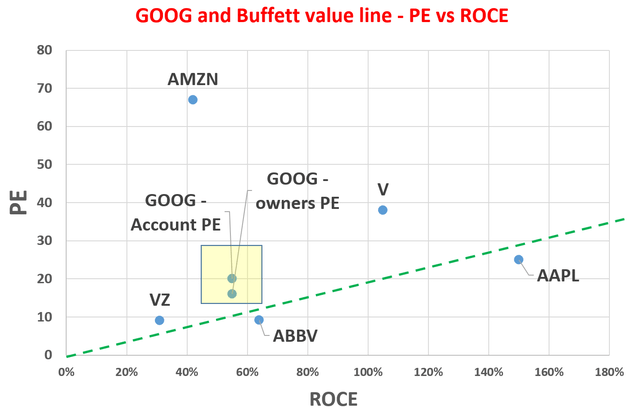
Looking forward,
- As shown in the next chart, at its current price levels, a double-digit total return can be easily supported in the longer terms. The long-term return is projected to consist of about 6% of owners’ earnings yield (again about 16x PE based on owners’ earnings as aforementioned) and about 5.5% organic growth.
- Such projection is on the conservative side because it excluded other important and potentially sizable return drivers. First, it excluded growth through acquisitions. For example, the next big GOOG catalysts will be the Google I/O developer conference due in two weeks, and CEO Pichai noted attendees would get some detail on the recent acquisition of MNDT in Cybersecurity. Second, it excluded the role of share repurchases. The Board of Directors just upsized the old share repurchase plan up to an additional $70B. Such a sizable repurchase, combined with its currently compressed valuation, will be very potent to boost shareholder returns. And finally, it excluded the nonlinear growth potential from its Other Bets category.
Author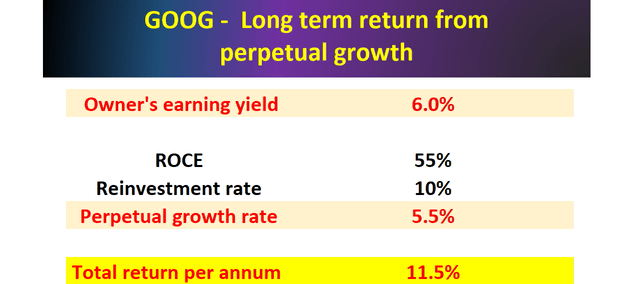
Conclusion And Risks
The market overaction to the Q1 earnings release has brought the valuation to a very attractive level. And the business still fits all the traits of a perpetual compounder fundamentally. In particular,
- Market concerns about its YouTube “slowdown” are overblown, while its rising TAC is of more fundamental concern.
- Its valuation is further distorted by its heavy investment in growth CAPEX, about 24% of its total CAPEX on average in recent years. As a result, its valuation is even lower than what is on the surface. The PE based on GAAP is below 20x now as of this writing, and the PE based on its true economic earning is only about 16x.
- Current price levels can support a double-digit total return conservatively. It is conservative because it excluded growth through acquisitions, the role of share repurchases, and the nonlinear growth potential from its Other Bets category.
Although there are a few risks to bear in mind (besides those mentioned already in the article such as the rising TAC costs):
First, the biggest one as I can see is the Russian/Ukraine war. GOOG has already suspended its commercial activities in Russia and such suspension has already hurt its profits. The duration and final outcome of the war are totally unpredictable (as with any war). And it could negatively impact the overall financial market and also Google. Even though GOOG’s own PE is in a very reasonable range as argued above. But the overall market itself is still near a historical record valuation and the war can create large market volatility. Such a combination of volatility and high market valuation certainly could cause some short-term risks for GOOG stock price.
Then there is also a remote possibility of an anti-trust regulatory risk. The US Justice Department has been investigating how Google maintains its power in the digital advertisement market. These investigations might lead to a second antitrust lawsuit against Google in the near future.




